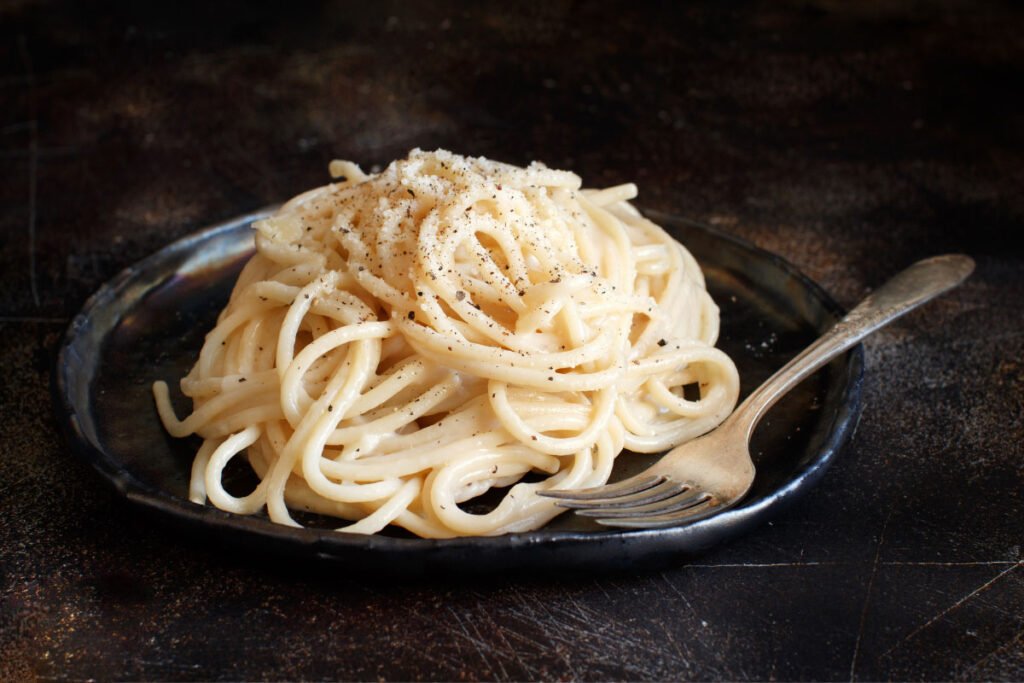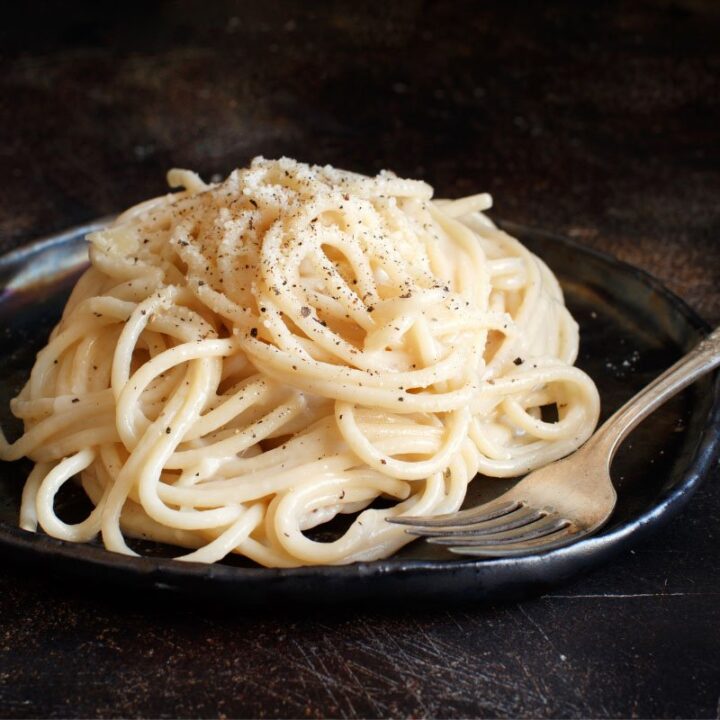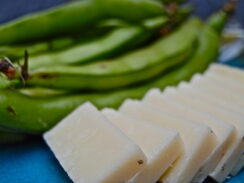Cacio e Pepe
 Rome is almost 3,000 years old. Or at least it will be in just over 200 years. According to legend, Romolo founded the city on April 21st of 753 B.C. But to understand that story, we should back up a few more years to the almost tragic birth of Romolo e Remo, or Romulus and Remus, as they are called in English.
Rome is almost 3,000 years old. Or at least it will be in just over 200 years. According to legend, Romolo founded the city on April 21st of 753 B.C. But to understand that story, we should back up a few more years to the almost tragic birth of Romolo e Remo, or Romulus and Remus, as they are called in English.
Purportedly conceived by their mother, Rhea, a Vestal Virgin, and the god Mars, the twins were abandoned at birth, placed in a basket, and floated down the Tiber River. The river was in flood stage, though, and their basket eventually washed to shore, where a lupa (she-wolf) found them and nursed them to health. The boys were eventually adopted and raised by a shepherd and his wife. Upon reaching adulthood, the boys decided to found a town at the same location where the lupa found and nursed them. They argued over the hill the new city should be built upon, though. Romolo wanted the town built on the Palatine Hill, while Remo preferred the Aventine Hill. In the quarrel that ensued, Romolo killed Remo, becoming the sole namesake of the city of Roma.
To commemorate Rome’s compleanno (birthday), we prepared one of the four quintessential Roman pastas, cacio e pepe, a classic of the cucina povera Romana. Cacio e pepe is made from just three ingredients: the hard, sharp, and salty sheep’s cheese Pecorino romano, cracked black pepper, and spaghetti. Disregard recipes that call for blends of cheeses, olive oil, or other ingredients – that’s not the real thing.
Cacio e pepe is a fixture on the menu of Rome’s traditional osterie and trattorie, and a fantastic pasta to make on a whim. Despite its simplicity, it requires the right technique to prepare it well. In a well-executed cacio e pepe, the Pecorino will turn creamy and smooth, coating the spaghetti perfectly.
Wine Pairing
One of our favorite wines to enjoy with cacio e pepe is an Orvieto from Argillae. It’s a bright, fresh white wine that holds up well with simple dishes like cacio e pepe. Stefano met one of the owner and wine makers, Giulia di Cosimo, granddaughter of founder Giuseppe Bonollo. Her authentic love for her work and the wines they produce was inspiring.

Cacio e Pepe
Cacio e pepe is a fixture on the menu of Rome’s traditional osterie and trattorie, and a fantastic pasta to make on a whim. Despite its simplicity, it requires the right technique to prepare it well. In a well-executed cacio e pepe, the Pecorino will turn creamy and smooth, coating the spaghetti perfectly.
Ingredients
- 1 package spaghetti
- 250 grams grated Pecorino Romano
- Freshly ground black pepper
- Salt
Instructions
- Bring a large pot of water to boil, and toss an abundant handful of salt into it.
- Add the pasta, and cook until al dente according to the time specified on the package.
- While the pasta is boiling, grate your cheese and have your black pepper ready to grind.
- Just before draining the pasta, remove several cups of the pasta water and set aside.
- When the pasta is al dente, drain it and return it immediately to the hot pot it cooked it.
- Add one ladle of the preserved cooking water and about 3/4 of the grated cheese, and toss together vigorously with two forks so that the cheese melts into a smooth sauce. If it seems too dry, add a little more of the cooking water. If it is too runny, add more cheese.
- Grind black pepper abundantly over the pasta, toss again.
- Serve immediately with a sprinkle of grated Pecorino Romano on top.


Frank
A beautiful dish in its utter simplicity, and yet it’s not easy to make well. I make it whenever I’m feeling nostalgic for my Roman days…
duespaghetti
We’ve had a lot of those days recently, Frank! It must be spring.
PolaM
You make it sound so easy! I never manage to get it quite to the right consistency 🙁 I think there must be a secret!
duespaghetti
Stefano’s the official mixer of the pecorino and pasta water when we make cacio e pepe – he gets it right every time. It must be a Roman thing : )
Carrie
I love the simplicity of this and need to give it a try. Oh how I miss, Rome. I don’t think my coin in the fountain ensured my quick return to Rome. (It was 2000 when I was there last!) Tomorrow is our anniversary and we’ll be celebrating Italy since that is where my husband proposed and where we took our Honeymoon. 😉
duespaghetti
Buon anniversario Carrie! The good news is that Rome will still be there to welcome you back when life finally permits you to return.
Carrie
🙂 True!!! It’s been around a loooooong time!
madlisa
Che bel piatto! A wonderful way to celebrate Roma’s birthday. Perhaps I will make it tonight. My pecorino mostly gets used for bucatini all’amatriciana. Beautiful photos too. I love that you married in Piazza Campidoglio! Perfect.
duespaghetti
Bucatini all’amatriciana – now there’s another delicious pasta! Perhaps we’ll have to go in search of some guanciale…
Simona
A perfect birthday dish! (You’ll see that we were on the same wavelength in terms of cheese this week.) thank you so much for contributing to Presto Pasta Nights.
duespaghetti
We were in fact thinking along the same lines! I think when spring comes each year we begin craving fava beans and pecorino. Thank you for hosting Presto Pasta Nights – it’s a fun event.
Jennifer Passudetti-Jacobs
Beautiful photos! Reminds me of my summer in Rome when I studied aboard. I linked over from bricoile and I look forward to reading more recipes.
duespaghetti
Thanks so much for stopping by Due Spaghetti, Jennifer! Briciole is one of our favorite blogs – we love to check in often to see what Simona is up to. Summers in Rome leave such memories – we think of strolling the piazzas and eating a pizza outdoors at night, when the city finally cools down a little!
Ruth
such a simple dish, but always one of my favorites. Your virtual trip to Rome was equally wonderful. Thanks for sharing the dish with Presto pasta Nights.